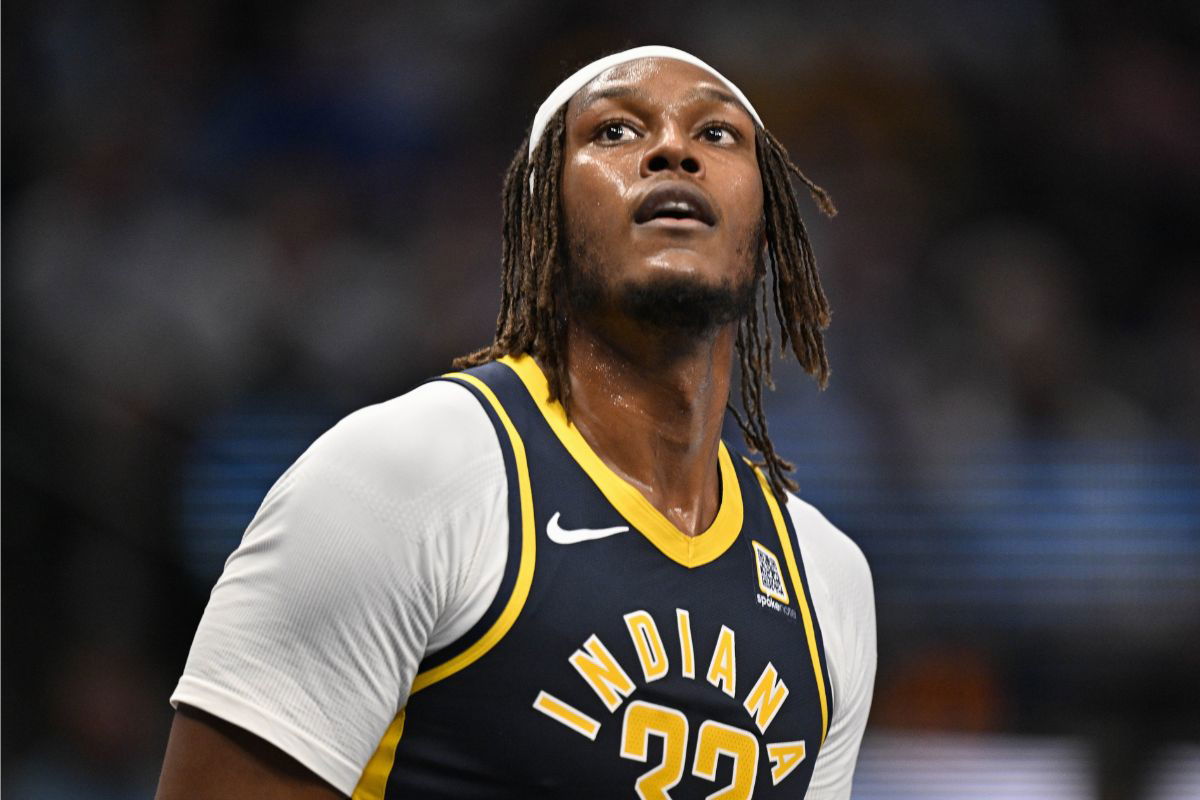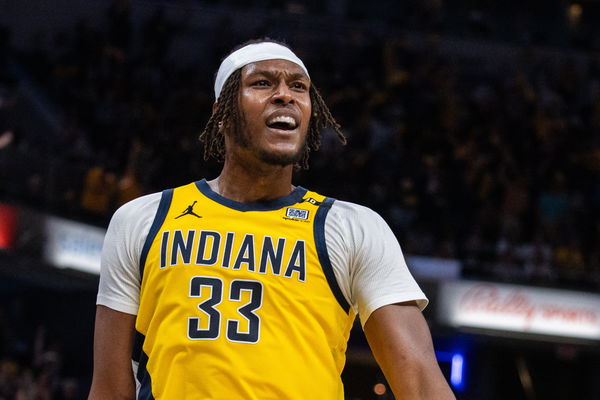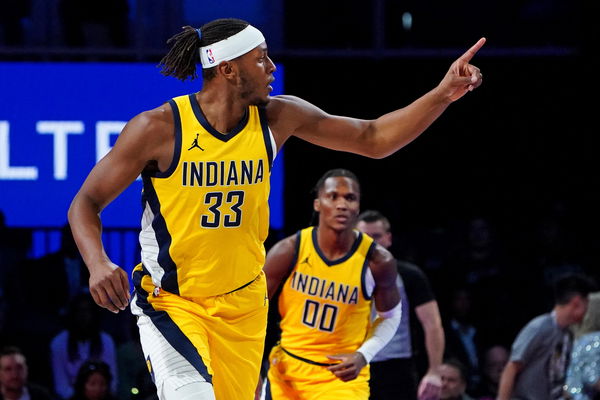
Imago
Nov 4, 2024; Dallas, Texas, USA; Indiana Pacers center Myles Turner (33) during the game between the Dallas Mavericks and the Indiana Pacers at American Airlines Center. Mandatory Credit: Jerome Miron-Imagn Images

Imago
Nov 4, 2024; Dallas, Texas, USA; Indiana Pacers center Myles Turner (33) during the game between the Dallas Mavericks and the Indiana Pacers at American Airlines Center. Mandatory Credit: Jerome Miron-Imagn Images
Just when the Indiana Pacers needed him most, Myles Turner was suddenly gone. With just under three minutes left in the third quarter, Turner hit the floor after a rough landing on his right leg while fighting for a rebound. At first, there was confusion. Then panic. Trainers sprinted over, teammates huddled, and fans went silent. In a matter of seconds, the tone inside Gainbridge Fieldhouse shifted from playoff fever to pure fear.
Watch What’s Trending Now!
The Pacers were trailing, the score at Cavaliers 83, Pacers 65. They’d spent most of the game in a deficit—down 21 at the half, and struggling to contain Donovan Mitchell, who had already piled up 22 points. Indiana’s offense had gone ice cold, and their defense couldn’t rotate fast enough to close Cleveland’s perimeter shooting. It wasn’t just a deficit—it was a collapse unfolding in real-time.
And then Turner went down.
ADVERTISEMENT
The 6-foot-11 center tried to play through it, even managing to score and block a shot, but was visibly hobbling—”skipping up and down like he can’t put weight on one of his feet normally,” reported Dustin Dopirak. Eventually, Turner crawled off the court before limping to the locker room—not under his own power. Not the way anyone wanted to see.

USA Today via Reuters
Apr 28, 2024; Indianapolis, Indiana, USA; Indiana Pacers center Myles Turner (33) celebrates a made basket during game four of the first round for the 2024 NBA playoffs against the Milwaukee Bucks at Gainbridge Fieldhouse. Mandatory Credit: Trevor Ruszkowski-USA TODAY Sports
This moment hit harder because of who Turner is—not just a key player, but a decade-long pillar of this franchise. From trade rumors to All-Defense snubs, from early playoff exits to the grind of multiple rebuilds, Turner has weathered every era of modern Pacers basketball. And this postseason was supposed to be his moment: a year removed from making the Eastern Conference Finals, surrounded by a healthy core, finally playing his best ball at both ends.
ADVERTISEMENT
He returned later in the game, a surprise that brought the crowd roaring back to life. In 21 minutes, he’d already poured in 14 points on 4-of-7 shooting, hit a three, gone 5-of-6 from the line, swatted three shots and played solid interior defense. But it was the limp, the way he left, and the fear that lingered in his absence that told the real story.
It added another layer to a game already teetering. Haliburton couldn’t get into rhythm. The offense looked stagnant. Cleveland was beating them to every 50/50 ball. And without Turner, even momentarily, the Pacers’ rim protection and floor spacing took a hit. For all the talk of Haliburton’s heroics and Siakam’s versatility, Myles Turner remains the emotional backbone of this team. And when that spine buckles—if only for a minute—Indiana feels it.
ADVERTISEMENT
That fear is amplified by his extensive injury history this season alone. Since October, Turner has battled through ankle tweaks, a calf strain, a sore oblique, neck pain, illness, a peroneal issue, hip tightness, and even a knee scare just a month ago. He’s been listed on the injury report a bunch of times since the season tipped off. This isn’t just about one awkward landing—it’s about the cumulative toll of a season spent limping through pain, taping up joints, and muscling through contact that rarely draws whistles in his favor.
As the Pacers fight to maintain their series lead, the focus shifts not just to tactics, but to survival. Can their veteran anchor stay upright? And if not, can Indiana carry him the way he’s carried them for ten years?
That’s the weight of this moment. That’s the story now.
ADVERTISEMENT
The Cost of Loyalty in a League That Doesn’t Wait
Because this isn’t just a playoff injury. This is the cost of loyalty. Myles Turner is not just another star in Indiana—he’s the star who never left. Through every rumor, rebuild, and injury, he stayed. When others chased bigger markets, brighter lights, or better odds, Turner quietly picked resilience. And that matters. In today’s NBA, that kind of loyalty is an artifact. A risk. A sacrifice.
He could’ve walked years ago—when Domantas Sabonis got the touches, when the team nearly signed his replacement in Deandre Ayton, when his body kept betraying him in silence, when playoff exits stacked up like scars. But Turner doubled down on Indiana. Again. And again. This fall, this limp, this scare—it’s not just bad luck. It’s a symbol. Of ten years spent proving he belongs. Of ten years in one jersey. Of ten years spent giving Indiana a reason to believe.
ADVERTISEMENT

USA Today via Reuters
Dec 7, 2023; Las Vegas, Nevada, USA; Indiana Pacers center Myles Turner (33) reacts after a play during the first quarter against the Milwaukee Bucks in the NBA In Season Tournament Semifinal at T-Mobile Arena. Mandatory Credit: Kyle Terada-USA TODAY Sports
Because here’s the truth: if you take Turner off the court, you don’t just lose rim protection. You lose spacing. You lose communication on defense. You lose a screener who frees Haliburton and Nembhard. You lose the guy who never asks for credit, who covers mistakes, who has blocked more shots than any center of this generation not named Gobert. You lose the glue.
Indiana runs on energy, pace, chaos—and Myles Turner is the eye of that storm. You don’t notice his calm until it’s missing. And when it’s missing, the storm consumes you. Haliburton is still working back from injury. Siakam has yet to fully impose himself. The offense flows best when Turner’s on the floor. Without him, everything tightens. The margin for error shrinks.
Myles Turner was a game-changer in the Pacers’ first-round takedown of the Milwaukee Bucks, and his Game 4 masterclass was the turning point. He dropped 23 points, swatted four shots, and added five boards—all while stretching the floor with clutch threes, including a key pick-and-pop triple that set the tone early.
Turner’s two-way impact was undeniable. He shut down the paint, making life tough for Giannis Antetokounmpo, and his shooting forced Milwaukee to abandon their drop coverage—giving Tyrese Haliburton more room to operate. That 129-103 blowout gave Indiana a 3-1 stranglehold, and when Game 5 went to overtime, Turner showed up again—racking up nine rebounds and making crucial plays that helped close out the series.
He’s not a luxury. He’s a necessity. And all of it—his growth, his sacrifice, his revival—might culminate in this postseason. Because looming over every play is this quiet truth: Turner will be an unrestricted free agent this summer.
If this is the final ride, make it unforgettable. Indiana fans know what it feels like to lose stars. Reggie. Paul. Vic. They’ve seen icons go. But Turner? Turner chose to stay. So now, the question isn’t just: “Is he healthy?”
It’s: “How do we honor what he’s given?”
He entered the league as a lanky kid with potential. He’s spent ten years being called “solid but not great.” And maybe he never made an All-Star team. But in this moment—in this postseason—he’s proven he’s more than the stat sheet.
He’s the guy who limped back into the game. The guy who always comes back. The guy who still believes. They called him “Potential Man.” But now, it’s time to call him what he is: Leader. Warrior. Pacer.
This series, this run, this postseason? It’s for 33. And if Indiana’s going to shock the world again, they better do it while he’s still out there. Because if you love basketball? You root for Myles Turner.
You root for the ones who stayed.
ADVERTISEMENT
ADVERTISEMENT
ADVERTISEMENT
ADVERTISEMENT

